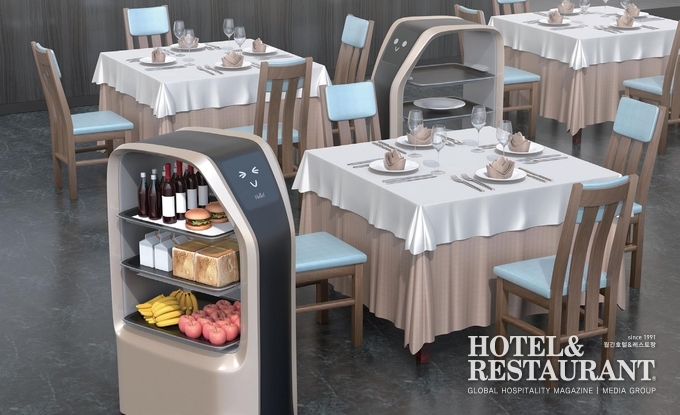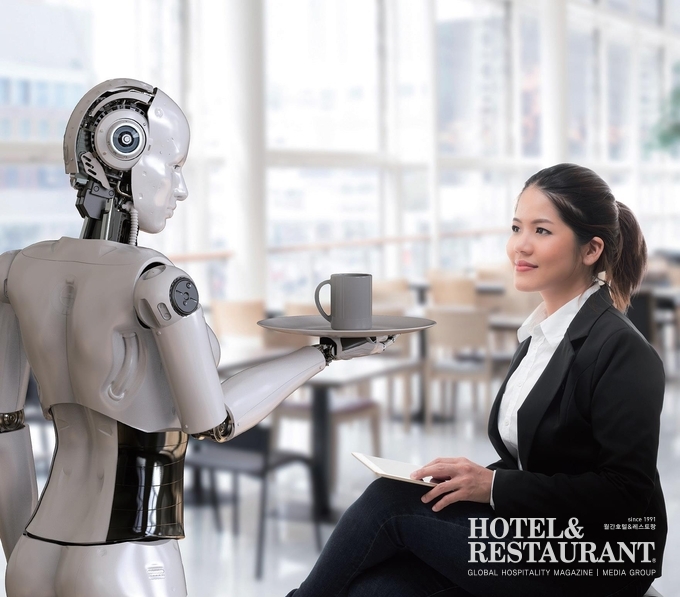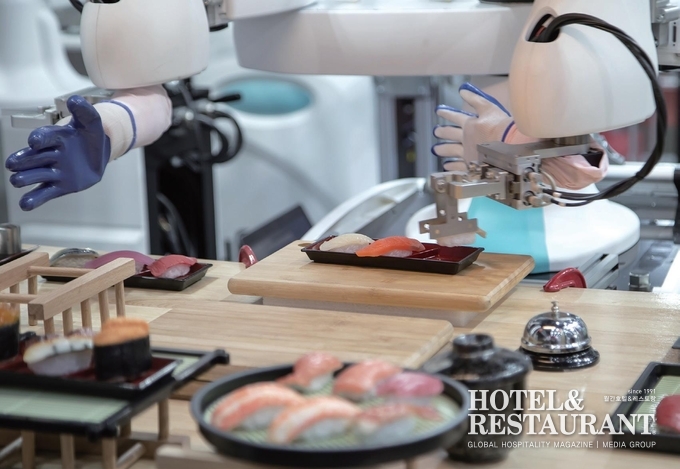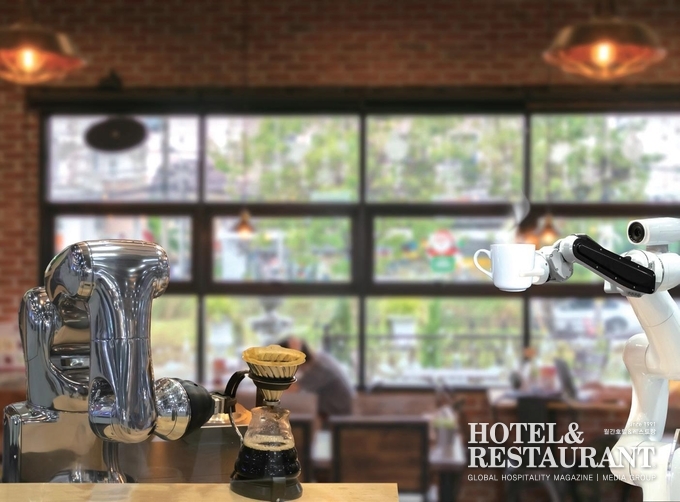
인적 서비스가 중심이 되는 레스토랑과 호텔은 인력 고용이 언제나 큰 과제다. 모든 안정된 브랜드들은 100% 제 역할을 해줄 수 있는 기량의 훈련된 직원들로 인력을 운용하길 원한다. 그러나 전 세계 최근 추이를 살펴보면 이러한 목표 달성이 점점 더 어려워지고 있음을 알 수 있다. 대부분의 젊은이들은 단순 노동 업무를 선택하려 하지 않고, 특히 아시아 국가들의 부모는 자녀의 교육 투자를 통해 최대한 육체노동에서 멀어질 수 있도록 미래 비전을 제시하고 있다. 미국과 같은 국가의 임금 수준은 숙련 된 근로자를 고용하기에 충분하지 않은 수준이고, 반대로 저출산과 초고령화의 그늘에서 벗어나지 못하고 있는 일본은 고용가능한 근로자가 갈수록 부족해지고 있는 실정이다. 실제로 일본의 맥도날드와 같은 대형 체인에는 50세 이상의 스태프들이 다수 근무하고 있다. 한편 호주와 같이 최저 임금과 사회복지 혜택이 높은 국가의 경우 직원을 고용하면 할수록 인건비 비중이 기하급수적으로 늘기 때문에 재정적 수익을 발생시키는 데에 한계가 있을 수밖에 없다.
이와 같은 이유로 고용의 어려움을 덜기 위해 자동화, 그리고 로보틱스의 기술을 도입하는 기업들이 늘어나고 있다. 그렇다면 이러한 솔루션이 레스토랑과 호텔에 현실적인 해결책이 될 수 있을까? 필자의 견해로는 현재 전 세계적으로 기술 솔루션의 발전 속도를 보면, 앞으로 자동화와 로보틱스 기술이 환대 산업에 있어서는 일선 서비스에서부터 주방 관리까지 활발히 도입될 수 있을 것으로 보인다.
필자는 최근 로스앤젤레스에 기반을 둔 ‘웨이브메이커 랩스(Wavemaker Labs)’와 협업하고 있는데, 음식 자동화에 조첨을 둔 벤처스튜디오 웨이브메이커 랩스에서 가장 주력으로 하는 업무는 반복적인 단순 노동에 의존하는 외식 기업에 기술을 제공하는 것이다. 그들이 협업하고 있는 기업 중 하나인 ‘미소 로보틱스(Miso Robotics)’는 ‘화이트 캐슬(White Castle)’과 같은 햄버거 체인에 햄버거 패티를 뒤집는 로봇 ‘플리피(Flippy)’를 제공하고 있다. 또 다른 기업은 높은 퀄리티의 피자를 요리하고 서브하는 자판기를 개발 중에 있고, 최근 관심을 두는 분야로는 빠르게 성장하고 있는 음료인 버블티 자동판매기가 있다. 자동판매기는 공항이나 기차역과 같이 바삐 움직이는 교통의 허브 지역뿐만 아니라 대학 내 식당 등에서도 널리 사용될 수 있어 기대를 모으고 있다.
코카콜라의 커피 브랜드인 ‘코스타 커피(Costa Coffee)’는 음료업계에서 핫 드링크 부문의 로보틱스 도입을 선도한 대표 주자인데, 필자도 최근 텍사스 오스틴 공항에서 코스타 커피의 키오스크를 경험할 기회가 있었다. 당시 스타벅스는 주문 대기가 많아 우선 주문까지도 상당한 시간이 소요됐기 때문에 코스타 커피에서 패드로 음료를 주문하게 됐다. 그리고 주문 후 2분 만에 맛있는 아메리카노 한 잔을 받을 수 있었다. 매장에 비치된 패드가 아니더라도 코스타 커피 앱을 다운로드하면 스마트 폰에서도 주문 결제가 가능했고, 주문 시 우유의 양과 종류, 단맛까지도 선택할 수 있도록 필터가 세분화돼 있었다. 코스타 커피는 이러한 로봇 솔루션을 전 세계 체인에 배포하고 있으며, 도입 초기인 현재까지 반응은 매우 뜨거운 상황이다.
그런데 외식 기업의 자동화 시스템 도입은 단순히 최근 나타나는 트렌드일까? 적어도 일본 외식 산업에 있어서는 새로운 것이 아니다. 가장 대표적으로 이미 일본 초밥 체인점에서 20년 넘게 컨베이어 벨트를 이용하고 있다. 로보틱스 기술을 도입한 초밥 레스토랑은 종업원의 불필요한 단순 노동은 줄이고, 초밥 제조 과정의 효율성을 개선하는 데 상당한 일조를 했다. 고객은 테이블의 터치패널을 사용해 좌석에서 음식을 주문하고, 주문한 초밥은 컨베이어 벨트에 의해 제공, 음식은 각자 주문한 테이블 앞에 멈춘다. 터치리스 결제 시스템도 일본에선 이미 흔하게 볼 수 있는 서비스였고, 이제 많은 대형 패밀리 레스토랑에서는 로봇 서버도 익숙해지고 있다.
한편 일본 요리의 자동화를 목표로 2014년에 설립된 ‘커넥티드 로보틱스(Connected Robotics)’는 최근 제품에 대한 높은 수요를 실감하고 있다. 그들이 개발한 최초의 로봇은 한 번에 최대 96개의 타코야키를 조리할 수 있는 기계인 ‘옥토 셰프(Octo Chef)’였다. 그 다음으로는 튀김, 베이컨, 계란 등의 비교적 단순한 공정의 요리 로봇과 전체 식기 세척을 담당하는 자동화 로봇이 있다. 고객에게 음식 조리 과정을 쇼처럼 보여주며 엔터테인먼트 요소를 가미시키는 한편 자동화 체인을 통해 인건비 절감의 효과를 이끄는 기술도 있다.
외식 서비스에 있어 로봇 솔루션은 아직 초기 단계에 놓여있다고 할 수 있지만 그간 짧은 시간 내 엄청난 진화를 거듭하고 있고, 앞으로 보다 세밀한 기술력으로 고급화될 수 있는 가능성도 무궁무진하다. AI는 인간의 판단이 필요하지 않은 반복적 프로세스를 자동화하는데 가장 적합한 기술일 뿐 아니라 주방 운영의 효율성을 도모할 수도 있다. 그러나 여전히 환대산업은 사람과 사람 간의 접촉과 서버, 셰프, 또는 매장 관리자와 고객 간의 네트워킹을 통해 완성된다. 따라서 환대산업의 이러한 본질과 인간이 사회적 동물이라는 사실은 로보틱스의 역할에 대한 기대치가 높아지고 있는 현재도 간과해서는 안 될 것이다.
하지만 그럼에도 불구하고 자동화 기술은 인간이 지루하고 일상적인 반복 작업을 수행할 에너지를 줄여주며, 더 흥미롭고 만족스러운 작업을 수행할 수 있도록 하는 데 도움을 주고 있다. 필자는 앞으로 대부분의 대형 글로벌 패스트푸드 체인이 향후 10년 안에 로보틱스화 될 것으로 확신하고 있다. 이제 로보틱스 기술은 더 이상 특별한 것이 아니다. 오히려 시간이 지남에 따라 더욱 그 영향력이 막대해질 것이다. 그렇다면 한국의 기업들은 어떤가? 한국 레스토랑과 호텔에서 자동화와 로보틱스의 기술을 어떻게 기회로 활용할 수 있을지 궁금해지는 대목이다.

Robotics & Automation – The Time Has Come!

Labor is always a large challenge to any restaurant or hotel business. Every great brand wants to operate with 100% fully staffed stores with team members who are 100% trained.
Recent trends around the world suggest that this goal is getting harder and harder to achieve. Many young people simply do not want to choose this life as a career. In Asia especially, parents want their children focused on their education and guide them away from any physical labor. In many countries like the USA, wages are simply not high enough to attract skilled workers.
While in Japan, there are simply too few workers available given the historical marriage and birth trends. For example, it is very common to see many team members 50 years old and above working at large chains like McDonald’s. In some cases, like Australia, with very high minimum wages and social benefits, it is simply not practical to be fully staffed and earn an acceptable financial return.
There is more and more discussion recently about using automation and robotics to ease the labor pains. Is this a realistic solution for many restaurants and hotels? When one looks around the world at the enormous progress made in technological solutions to both kitchen management and front-line service, I think we can be quite optimistic that these solutions will become more and more adopted by hospitality groups going forward.
I am currently working with an organization based in Los Angeles, wavemaker labs, whose main focus is providing disruptive technologies to companies that rely on operations with many repetitive tasks, that could better be done my machines. One of their companies, Miso Robotics, is providing burger flipping robotic technology to well-known hamburger chains such as White Castle. Another of their companies is developing a vending machine to cook & serve high quality pizza. A further market segment for development is a bubble tea vending machine to take advantage of the growing interest in this beverage category. The vending machines could be widely popular in busy transportation hubs like airports or train stations as well as University food service halls.
Costa Coffee is a leader in the robotics vending category for hot beverages and I recently had the opportunity to experience their kiosk at the airport in Austin, Texas. The Starbucks store had a very long line and a long wait for service, so I simply used the ordering pad next to the machine to buy my beverage of choice and I received in 2 minutes a tasty cup of Americano. I could have done the whole transaction on my smartphone if I was willing to download the Costa Coffee app. I was able to choose the amount of milk (half & half, low fat, or soy) as well as the sweetness level. Costa, now a division of Coca-Cola, is rolling out these robotic solutions globally and the early results are very promising.
Automation is of course nothing new in the foodservice industry in Japan. Many conveyor belt sushi chains have been working with robotics for over 20 years to eliminate back of the house labor and improve efficiency in the sushi making process. They have mostly eliminated the hostess and servers as well. Diners use a touch panel to choose their seats and then order their food from touch panels at their table. The sushi comes by conveyor belt and stops at the appropriate table where the customers take their food. Touchless payment is also very common. Many budget family restaurant chains have also started to use robots as servers to deliver food to seated customers.
Connected Robotics, founded in 2014, with the goal of automating the preparation of Japanese cuisine, is experiencing strong demand for its products. Its first robot was OctoChef, a machine that could prepare and cook up to 96 takoyaki at one time. It has other robots to prepare and cook fried foods, bacon and eggs, and one that automates the entire dishwashing process.
There are also chains that have automated the yakitori cooking process to show both some food theatre to their customers as well as cut labor costs.
It must be said that robotics solutions for foodservice is still in the infancy stages but there has been enormous progress and the use of advanced AI shows great promise. AI is best used to automate repetitive processes where human judgment is not required so basic kitchen operations is a segment that could greatly benefit.
Despite the rising interest in robotics, we must all remember that the hospitality industry is all about human contact and the positive impacts of personal connections with a server, Chef or store manager. We are still very much social creatures. Nevertheless, automation is a clear necessity in the kitchen to help reduce the need for humans to perform mundane repetitive tasks and free them to do more interesting & fulfilling work. I am confident that most large global fast food chains will be using some form of robotics in their operations over the next 10 years. Robotics is definitely here to stay and will become increasingly more important as time goes on. Does your organization have an internal group looking at these opportunities?

 Joel Silverstein Joel Silverstein
이스트웨스트 호스피탈리티 그룹 대표 현재 홍콩에 거주하며 최고 경영진과 포춘(Fortune) 500대 기업이 다수 아시아 국가에서 지속가능한 성장을 할 수 있게 도와주고 있다. |
- 2024.11.05(화)~2024.11.11(월) 투어리즘&마이스 서울특별시관광협회, 제27대 협회장 후보자 등록 실시
- 2024.10.25(금)~2024.11.07(목) 대회·공모전 "서울 관광산업 발전에 기여한 자를 찾습니다."…서울특별시관광협회(STA), 2024 서울관광대상 수상 후보자 모집
- 2024.10.18(금)~2024.10.19(토) 축제 한국관광공사, 원주 시민과 함께하는 ‘세계로(路) 페스타’개최
- 2024.10.13(일)~2024.10.20(일) 축제 하슬라국제예술제 오는 13일 개막… 공연장으로 탈바꿈한 강릉 정체성 담긴 장소들
- 2024.10.5(토)~2024.11.3(일) 축제 대한민국 대표 공연관광 축제 ‘2024 웰컴대학로’ 개최
- [Joel의 Global Dining Market] 가상공간의 외식 브랜드 시장 속에 실재할 수 있을까? 2021-04-05
- [Joel의 Global Dining Market] 뉴노멀에 적응하는 식당가들의 새로운 전략_ 배달음식 전문점 2020-11-12
- [Joel의 Global Dining Market] 해외 진출의 관문? 홍콩 시장의 인기_ 외식업계 위기와 변화 면밀히 살펴봐야 2020-09-20
- [Joel의 Global Dining Market] 코로나19의 여파, 미국 외식 산업의 위기_ 더 좋은 음식과 더 나은 서비스로 고객 공략해야 2020-08-03
- [Joel의 Global Dining Market] 코로나19로 기세 오른 플랫폼 비즈니스_ 레스토랑과 상생하는 모델 모색해야 2020-06-02
- [Joel의 Global Dining Market] 아픈 손가락의 성장 필리핀 2020-04-20
- [Joel의 Global Dining Market] 크로아티아 발칸 반도의 맛을 경험하다 2020-02-10
-

[홍주석의 MICE Guide] 스토리의 힘, 마음을 움직이는 이야기의 예술
- 2024-11-13
- 홍주석 칼럼니스트
-

만다린 오리엔탈 호텔 그룹, 중화권 포트폴리오 확장 가속화
- 2024-11-12
- 안수진 기자
-

파르나스 호텔 제주, 한국관광공사 주최 ‘2024 중문데이’ 공식 호텔로 참여
- 2024-11-12
- 안수진 기자
-

[Tourism Issue] 도시재생의 새로운 패러다임 ‘마을호텔’의 부상과 과제
- 2024-11-12
- 안수진 기자
-

븟컴퍼니-제뉴인그립-어드밴스드, 퀴진, 2세대 셰프테이너들의 지속가능한 활약 지원
- 2024-11-11
- 서현진 기자
-

워커힐 호텔앤리조트, ‘제8회 김장 담그는 날’ 행사 개최
- 2024-11-11
- 서현진 기자






























